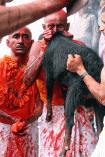
 “The purpose of revisiting the question of “whether the ancients ate beef?” is funny. What if one were to discover that our ancients did indeed eat men? Do we tolerate those who do it today? Or even better, give scriptural justifications as to why it may have been or should be done today?” – Shrivathsa B.
“The purpose of revisiting the question of “whether the ancients ate beef?” is funny. What if one were to discover that our ancients did indeed eat men? Do we tolerate those who do it today? Or even better, give scriptural justifications as to why it may have been or should be done today?” – Shrivathsa B.
Learned readers may read an article by a scholar of our times, Dr R. Ganesh (RG from here on) here. The title of the article is “The Hindu View on Food and Drink” and has been published in India Facts. As the article touches quite a few aspects spanning history, dharma, etc., it is difficult to write a comprehensive response in the comments section.
 A few disclaimers
A few disclaimers
Dr Ganesh is a respected personal friend and I have benefited intellectually from his long but irregular association. The association is old enough for me to analyze his article’s position vis-a-vis his positions about other issues that he has held in the past. To this extent, my judgment of RG and his article is coloured. Certain points of his article are analyzed here avoiding personalizing the argument to the extent possible. This article is not about RG’s scholarship for which he doesn’t need any certificates.
Food and drink vis-a-vis airplanes in ancient India or the “utility”
By “utility” we mean the purpose of revisiting the past. This involves asking questions such as: did our ancients indulge in incest, were they cannibals, etc. RG’s article fails this test. Let us analyze it further. Here is a similar case from the recent past.
Recently there were reports of a few overenthusiastic people trying to prove that ancient India did indeed have planes. At that time, it was a reasonable stance of various scholars (one would reasonably include RG) that:
- The purported planes as quoted in the Vaimānika Sāstra as studied and analyzed by two scientists of the Indian Institute of Science, simply cannot fly.
- Whether our ancients indeed flew planes is irrelevant to the current crying weaknesses in our own aviation sector and this gloating amounts, at best, to precious nothing and at worst, leads to self-congratulatory complacence.
The purpose of revisiting the question of “whether the ancients ate beef?” is funny. What if one were to discover that our ancients did indeed eat men? Do we tolerate those who do it today? Or even better, give scriptural justifications as to why it may have been or should be done today?
The “utility” argument is not a censor, but it will be useful to the authors to nuance their arguments.
 The title
The title
One is at a loss to understand the purpose the title “The Hindu View on Food and Drink”. One could have titled it to suit the contents of the article as: “The Hindu View of Meat-Eating, Beef-Eating and Drinking”. But then, this much can be given as gratuitous advice and nothing more. One would have been forgiven for looking forward to an exposition about food as in the Hindu śāstra granthas. To see the beef question again was a let-down. But then, this may be quite subjective and we will also have to account for the possibility of the title being sanitized by the editors (a reasonable speculation).
Having said the above, the authors need to be told that the confusion and let-down may have been the experience of many people. If causing such a confusion was intentional, something like a snare to get the unprepared reader hooked on to more controversial questions, is something that the authors / editors may convey to us (if at all) at their convenience.
The purpose
Many are too intellectually small to tell RG that either articles have a purpose, or ultimately they are utilized. The latter is what some “activists” are concerned about (in the comments section). The exchange is quite emotional and heated. The fear being that scholars such as RG with a purported Hindu background are espousing a position which is ill at ease with the current status of cows in India. The charge being that the scholars are unwittingly scoring a self-goal. This self-goal is dangerous, considering that the consequences of wrong utilization of the article’s thesis has to do with
- lives of animals which are exceptionally beneficial to the national economy;
- food security: proper utilization of cow dung, cow urine, etc. will result in healthier soils which can preserve productivity over longer periods of time;
- reducing and alleviating soil degradation: cow dung and cow urine have a beneficial effect on degraded soils;
- agricultural profitability: farming using cow dung, etc. will result in greater productivity and hence greater profits sustainably. Utilization of compost, cow dung, cow urine, etc. is the way to a sustainable agriculture.
Exhortation to, or justification of beef-eating will jeopardize all the above.
 Progress of traditions and need of Dharma changing its definition / application dynamically
Progress of traditions and need of Dharma changing its definition / application dynamically
There can be no dharma which goes against common sense. To espouse neutrality about eating beef in India is against dharma. Let us explore this in more detail.
RG as far as I know, forcefully asserts that the definition and application of dharma changes dynamically with time. This is a reasonable position to take, but appears opposite to the intent of the current article. Let us paraphrase the intent of the article in simpler words (if the author meant something else, one will be fortunate to be enlightened):
- Indians ate beef in ancient / medieval India.
- We, as Hindus, as confirmed by our texts, did not take any moral stand about meat-eating and beef-eating.
- Hence, we, as Hindus today shouldn’t take a moral stand about meat-eating and beef-eating.
Where does the above message sit with the consistent and reasonable position that regardless of whatever the ancients did, we have to bother about the current day and age. That is, the definition of dharma being dynamic, doesn’t allow one to override common world considerations. Consider the above, with the possibility ofdesi breeds of cows becoming extinct due to rampant culling. India is also staring at the possibility of becoming a net importer of milk very soon. In the face of this, to maintain a neutral stance about eating beef is intellectually irresponsible. RG has been a signatory to a recent petition seeking a review of the way history is being written and taught in India. A bit of intellectual responsibility is not too much to expect of him. Intellectual irresponsibility is a charge which can be fairly thrown at RG’s article, in spite of the exhortation at the end about being responsible about meat-eating, etc. (which appears more as an afterthought).
Hence, the line of arguing whether or not ancient Indians ate beef, whether they indulged in incest, or ate human flesh, etc. neither satisfy the utility requirement, nor are they in tune with the dynamic definition of dharma. What matters is the current definition of dharma which seems unequivocally against eating beef.
Dharma and nīti
Any nīti (principles / law applied in real world) adopted should be conducive to establishment and nourishing of dharma. The naitika line adopted by the article seems ill at ease with this.
Current dhārmic requirement on nīti needs to take into account the following:
- Growing population and unsustainable models of chemical-based agriculture has led to a scary situation where soil degradation threatens long-term food security. This should be seen in the light of the benefits of sustainable models of organic agriculture. No use scoffing at this, any visit to any Krishi Mela will convince one of the growing awareness in farmers about issues connected to this.
- The prospect of cow dung playing a part in the long-term energy security of the country. According to estimates, about 1 lakh 32 thousand crore rupees per year can be saved in fuel costs by adopting dung derived methane as an alternative fuel. Just consider shutting down an industry which produces profits of Rs 1 lakh 32 thousand crore only through byproducts. Will any sane government / community allow this?
- The role the cow plays in the rural economy as a tool of economic empowerment.
Apparently, one finds killing a man for his coat to be offensive, what about killing a cow for merely its leather or meat?
 Scriptural justification for acts committed by people
Scriptural justification for acts committed by people
The article, wittingly or otherwise also ends up being an apology for people who seek to eat beef. If someone wants to eat beef, why would he require scriptural authority to do so and vice versa? Just because we are faced with a culture which seeks to make beef-eating as acceptable, do we capitulate before such a culture and find out scriptural justifications for eating beef? In other words, do we make the definition of dharmaso dynamic as to include adharma?
If the above is misconstrued as merely rhetorical, the substantial arguments against eating beef can be found in the texts themselves. It will become amply clear that RG has presented a one-sided view of tradition and its interpretations without looking at the counter arguments in the same texts.
Evidence from brāhmaṇa literature
The definitive argument against eating any form of meat is found in the most ancient text concerning Vedic rites, the Aitareya Brāhmaṇa. The eighth and ninthkhaṇḍas of the sixth adhyāya contains a brāhmaṇic story of a puruṣa who was about to be sacrificed in a yajña (conducted by devas). The best material in him escapes because of the fear of death and enters various animal bodies and escapes them in sequence. It finally enters earth and then the grains. The sum and substance of the brāhmaṇic story is that the person conducting a sacrificial rite using puroḍāsha (a grain preparation) is indeed doing an animal sacrifice. This is because of the yajña paśu has passed the bodies of various animals, earth and finally the grains. The drift being that grains have the best essence of all animals and the earth. The text also provides equivalence between the body parts of an animal and the different parts of a grain.
This seems to suggest that there was either (1) a parallel tradition which practiced sacrifices using grain alone; or (2) an opprobrium associated with animal sacrifice—which led to a brāhmaṇic story such as the above.
In any of the above cases it can be safely argued that the concept of sacrifices of the animal variety as the only means of attaining heaven was being reviewed by the ancients (thereby the story extolling grain over meat).
 Animal sacrifice prohibited according Mahābhārata
Animal sacrifice prohibited according Mahābhārata
The anuśāsana parva of Mahābhārata holds a view strictly against animal sacrifice of any sort. This is explained by the story of King Vasu. The story being: A king by name Vasu goes to heaven as a result of conducting yajñas. After he reached heaven, there happens to be a debate among thedevas and ṛṣis about the use of goats, etc. in sacrifice. In this debate, the devas are in favour of goat sacrifice andṛṣis favour oblation of unsprouted seeds. The tussle is about the word “aja” which can either mean unsprouted seeds or a goat. They decide that as Vasu has reached heaven performing yajñas, he is the right person to be consulted. Vasu, who is now a deva himself decides to be partial to the deva view and gives the verdict in favour of goats being killed. As a result of this, he is cursed immediately to be born on earth as a snake.
A question of proportion
Whenever any argument is made, it makes sense for it to preserve proportions. The argument presented in RG’s article fails the above test. It seeks to promote a view that Hindus were beef-eaters, as though they were eating beef at least once a week (if not every day). Let us ask a few questions and answer them.
Que: Who are the ancients who are supposed to have eaten beef, if at all?
Ans: A subset of Brahmins called yājñika Brahmins who have done or taken part in somayāga. This is a “difficult” yāga to conduct owing to the requirement of numerous priests of a very high erudition. Generally the convention was for theyajamāna and his next seven generations to carry surnames such as somayājī,vājapeyī, etc. Any cursory population analysis of the Brahmins will reveal that the number is minuscule. Brahmins had other vocations such as temple duties, official duties in the royal court and the like. In fact, some communities in Brahmins are classified as (1) Kammis (corruption of “karmī”, i.e. worker) who were predominantly officials by tradition. (2) Ācārya: who were traditional school teachers. (3) Joshi: the ones predominantly traditional astrologers (4) Purāṇika: the ones who were traditional story tellers, bards etc. This being the case, the number of those who have eaten beef, if at all, is minuscule.
Que: How often did they eat beef (if at all)?
Ans: Somayāga was not a daily event. It had strict restrictions on its conduct including restrictions on
- the time of the year: certain varṇas had to conduct it in certain seasons;
- the yajamāna (the one on behalf of whom the yajña is conducted): before even beginning a somayāga, he should have (a) been an āhitāgni, (b) conducted the sapta pāka and sapta havissamsthas. Except in the case of a chosen few who probably had royal backing, to be an āhitāgni and have finished the samsthas is quite difficult practically;
- Ayajño vā etadadakṣiṇaḥ (that which doesn’t have substantial dakṣiṇā is not fit to be called a yajna) goes a famous maxim. Stories abound in itihāsaand purāṇa about kings giving away everything they had. The rājasūyasacrifice calls for giving away even the loin cloth worn by the king. Given this, the number of those even among even the yājñikas who were regularly conducting yāga is logically low;
- once seven Somayāgas are done, the yajamāna is supposed to have attained the merit of going to heaven, hence it isn’t necessary for him to do any more yāgas. So, at the most, he and the priests may have eaten beef seven times in their life (if at all).
The above being the case, any argument based on right proportions should qualify RG’s argument as follows:
“There were a minuscule few people in ancient India who used to conduct occasional sacrifices involving killing of animals, this too, in spite of scriptural injunctions against such a practice.”
To conclude in any other way will be intellectually dishonest and the authors of the article are indeed guilty of distorting proportions in a discussion on history.
 The incompatibility of beef in madhuparka
The incompatibility of beef in madhuparka
The article touches the oft-repeated Uttararāma Caritainstance where Vasiṣṭha is purportedly served beefmadhuparka.
Interested people may read the book A Review of Beef in Medieval India here. The book provides logical arguments refuting the idea of beef in madhuparka. A summary is given below:
- Impracticality of sacrificing a cow or a calf in the welcome ritual: All acts ofarghya, pādya, etc. are to be done continuously. One cannot give pādya and ask the visitor to wait till a calf is brought, killed, meat extracted, cooked, mixed with other ingredients and served. It is clear from this that the calf would have been shown to the visitor, if he be interested in taking it home, he give consent, otherwise ask the host to let it free.
- The incompatibility between what is meant in the mantra and what was purportedly done. The mantra clearly says, “don’t kill a cow.”
-
The incompatibility of mixing beef in madhuparka. The authors of the book have written to the best chefs of international hotels. The chefs have attested to the incompatibility of mixing cooked beef with a sweet preparation made of milk and curd.
-
The ritual of madhuparka which has been preserved in its non-beef form even in a monastery situated in a hard-core-meat-eating country.
In view of all the above, it can be safely concluded that RG’s article cannot be considered the “Hindu” view of food.
 Selective invoking of certain commentators
Selective invoking of certain commentators
A scaremongering trick indulged in many of those arguing on behalf of RG in the comments section is selective invoking of commentators such as Sayana, etc. At times this is done in an aggressive display of faux scholarship with a “you know nothing” tone. To such people, we may submit the following: even if there are references to animal sacrifice, it serves nobody’s long-term interest today to justify slaughtering cows. There have been many customs which we have either willingly or otherwise given up, what about giving up a thing which wasn’t a custom at all?
May better sense prevail on the authors. They have written a rebuttal to the comments they have received, we will try to analyze that article at a later date. – ParyAyavAk, 23 November 2015
» Shrivathsa B. is the Director of Bhagirathi Engineering Solutions in Bengaluru. He also teaches Valmiki Ramayanam and is a student of Sama and Rig Vedas.













 Selective invoking of certain commentators
Selective invoking of certain commentators